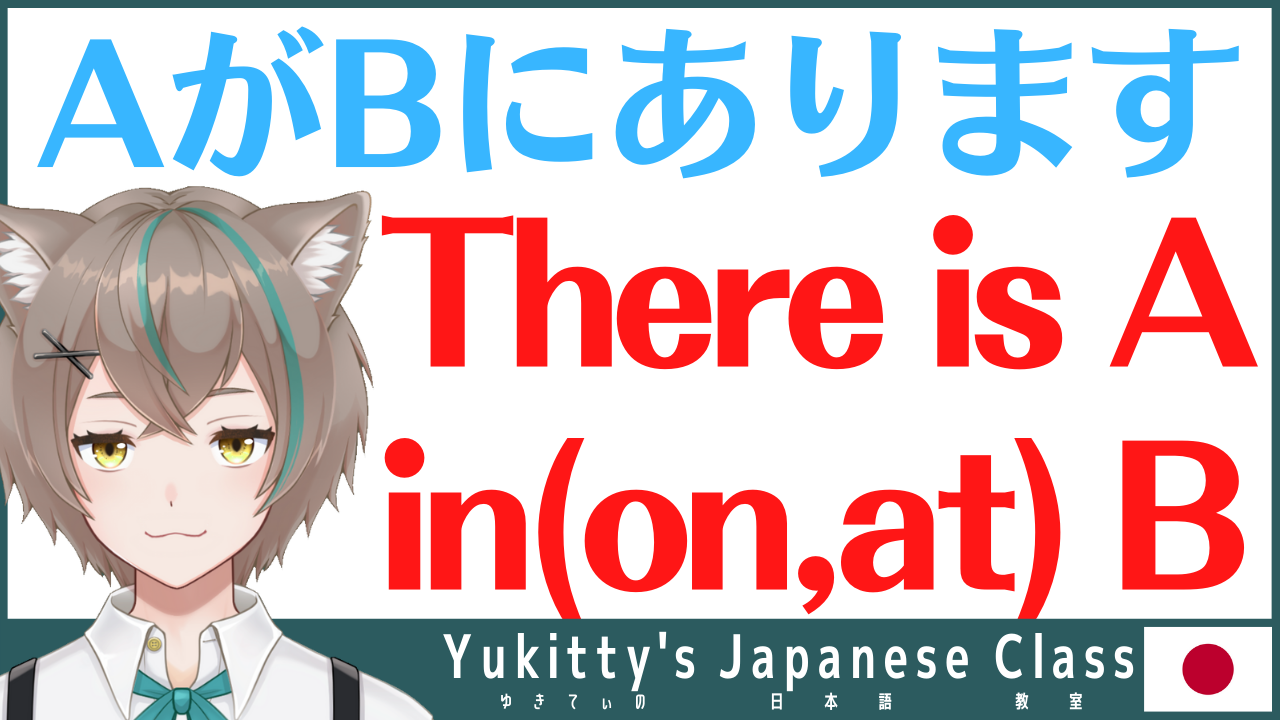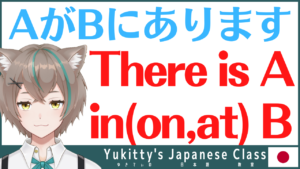


AがBにあります。
When pointing a living thing, います is used instead of あります。
When you want to say only the existence of A, you can omit B.
The postpositional particles “が” and “に” are important. They can be swapped like “BにAがあります。”. It has the same meaning as before swapped.
“が” is a subject marker, the word before “が” is the subject of the sentence.
However, you can’t forget that subjects are often omitted in Japanese sentences. If the B is obvious in the context, it is most omitted.

You can use “は” instead of “が”, in this case, the A is not a subject but a topic, because “は” is a topic marker.
For example, “AはBにあります。” is a nuance like “Regarding A, it is at B.”, but many Japanese people don’t understand this difference.
| Japanese | Hiragana | Relationship with B | Locations (EN) | Directions (EN) |
|---|---|---|---|---|
| 上 | うえ | Bの上 | above B, on B | up |
| 下 | した | Bの下 | under B | down |
| 右 | みぎ | Bの右 | to the right of B | right |
| 左 | ひだり | Bの左 | to the left of B | left |
| 前 | まえ | Bの前 | in front of B | front |
| 後ろ | うしろ | Bの後ろ | behind B | back / rear |
| 中 | なか | Bの中 | in B, inside B | in |
| 近く, そば | ちかく, そば | Bの近く, Bのそば | near B | – |
| 隣 | となり | Bの隣 | next to B | – |
| 横 | よこ | Bの横 | to the side of B | – |
| 間 | あいだ | BとCの間 | between B and C | – |
| ここ | こっち(directions) | ここ | here | – |
| そこ | そっち(directions) | そこ | there (your place) | – |
| あそこ | あっち(directions) | あそこ | over there | – |



The directions that do not interfere with each other can be said in combination.
For example, 右上 means upper right, 左後ろ means left-back, etc.
右 or 左 are first, 上, 下, 前, 後ろ, 隣 and 横 follow them.
There is a convenience store over there.
コンビニ [noun] convenience store
There is a cat in the bag.
猫 [noun] cat
かばん [noun] bag
There is Satoshi on the right back of Pikachu.
Translate the following sentences into Japanese using the words about directions and locations.
There is a banana on the desk.
バナナ [noun] banana
There is a banana on the desk.
バナナが机の上にあります。
Another correct answer: 机の上にバナナがあります。
There is an escape button on the upper left of the self-destruct button.
脱出 [noun] escape
ボタン [noun] button
自爆 [noun] self-destruct
There is an escape button on the upper left of the self-destruct button.
脱出ボタンが自爆ボタンの左上にあります。
Another correct answer: 自爆ボタンの左上に脱出ボタンがあります。
There is a Mario in the pipe under the Piranha Plant.
土管 [noun] Earthen pipe
パックンフラワー [noun] Piranha Plant
There is a Mario in the pipe under the Piranha Plant.
マリオがパックンフラワーの下の土管の中にいます。
Another correct answer: パックンフラワーの下の土管の中にマリオがいます。
その(=the) is normally omitted unless the speaker wants to emphasize it.
あります is also used for the existence of time or event.
Whan, you say that you have time, “に” disappears or is changed to “は”. (BはAがあります。*) *word order is fixed
When saying the existence of an event, “に” is changed to “で”. (AがBであります。)
The negative expression of “あります” is “ありません”, “います” is “いません”.
| Japanese | Negative expression | What for |
|---|---|---|
| あります | ありません | things (polite) |
| います | いません | living things (polite) |
| ある | ない | things |
| いる | いない | living things |
I have time tomorrow.
明日 [noun] tomorrow
時間 [noun] time
私は is omitted.
There will be a festival in the neighborhood next week.
来週 [noun] next week
近所 [noun] neighborhood
お祭り [noun] festival
There is no wallet.
財布 [noun] wallet
Is anyone there?
誰か [noun] anyone


この記事が気に入ったら
フォローしてね!
Comment